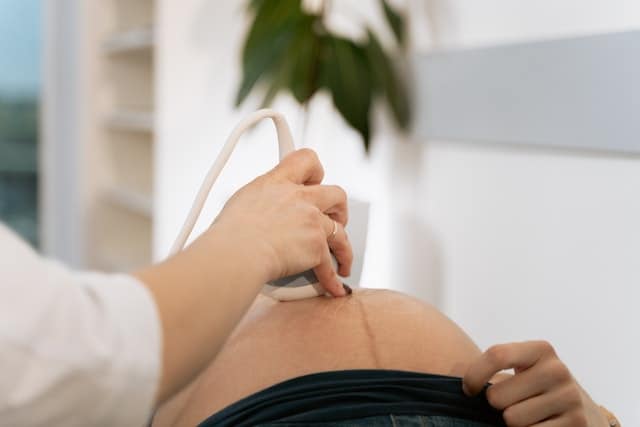Anterior placenta is a common condition that affects many pregnant women. It occurs when the placenta attaches to the front wall of the uterus, rather than the back or side.
While anterior placenta does not usually cause any health problems for the mother or baby, it can lead to a bigger belly and affect fetal movements.
Understanding Anterior Placenta: Anterior placenta is a condition that affects around 20% of pregnant women. It occurs when the placenta attaches to the front wall of the uterus, rather than the back or side.
This can make it more difficult to feel fetal movements, as the placenta acts as a cushion between the baby and the mother’s abdominal wall. However, anterior placenta does not usually cause any health problems for the mother or baby.
Anterior Placenta and Bigger Belly: One of the most noticeable effects of anterior placenta is that it can lead to a bigger belly. This is because the placenta is located at the front of the uterus, pushing the baby further forward.
As a result, women with anterior placenta may appear to be carrying their baby more prominently. While a bigger belly is not necessarily a cause for concern, it is important to monitor fetal growth and development to ensure that the baby is healthy.
Key Takeaways
- Anterior placenta is a condition that affects around 20% of pregnant women and occurs when the placenta attaches to the front wall of the uterus.
- Anterior placenta can lead to a bigger belly and affect fetal movements, but does not usually cause any health problems for the mother or baby.
- Women with anterior placenta should monitor fetal growth and development to ensure that the baby is healthy.
Understanding Anterior Placenta
During pregnancy, the placenta plays an essential role in the development of the fetus. It is an organ that connects the developing fetus to the uterine wall, allowing for the exchange of nutrients, oxygen, and waste products.
The location of the placenta can vary, and one common location is the anterior placenta.
An anterior placenta is when the placenta attaches to the front wall of the uterus, closest to the mother’s abdomen. This location can have some effects on the pregnancy and the mother’s experience.
One of the most noticeable effects of an anterior placenta is that the mother may have a larger belly. This is because the placenta is between the fetus and the mother’s abdominal wall, making it more difficult to feel the baby’s movements.
However, this is not a cause for concern, as the baby is still developing normally.
An anterior placenta can also affect the accuracy of ultrasound scans. The placenta may block the view of certain parts of the fetus, making it more challenging to get clear images.
However, most ultrasound technicians are trained to work around this and can still obtain the necessary information.
Overall, having an anterior placenta is a common occurrence during pregnancy and does not usually cause any significant problems. It is essential to discuss any concerns with a healthcare provider, as they can provide personalized advice and support.
Anterior Placenta and Bigger Belly
When a woman has an anterior placenta, it can affect the size and shape of her baby bump. The placenta is an organ that develops during pregnancy and attaches to the uterine wall to allow nutrients and oxygen to pass from the mother to the fetus.
An anterior placenta is located on the front wall of the uterus, between the baby and the mother’s abdominal wall.
This placement can make the baby bump appear smaller than it would with a posterior placenta, which is located on the back wall of the uterus. However, it can also make the belly appear larger in some cases.
The reason for this is that the anterior placenta can cause the abdominal muscles to stretch and separate more than usual.
This can result in a condition known as diastasis recti, where the abdominal muscles become weakened and the belly protrudes more than it would with a stronger core.
It is important for women with an anterior placenta to be aware of this possibility and to take steps to prevent or address diastasis recti.
This can include exercises to strengthen the abdominal muscles, wearing supportive clothing, and avoiding activities that put too much strain on the core.
In conclusion, while an anterior placenta can affect the appearance of a woman’s baby bump, it is important to focus on maintaining a healthy pregnancy and addressing any potential issues related to diastasis recti.
Anterior Placenta and Fetal Movements
During pregnancy, feeling the baby kick and move inside the womb is a reassuring sign of fetal well-being. However, women with an anterior placenta may experience reduced fetal movements or difficulty feeling the baby’s kicks.
An anterior placenta is a condition where the placenta attaches to the front wall of the uterus, between the baby and the mother’s abdominal wall. This placement can cushion the baby’s movements, making it harder for the mother to feel them.
It is important to note that reduced fetal movements do not necessarily indicate a problem with the baby’s health. However, it is still important to monitor fetal movements and seek medical attention if there is a significant decrease in movement.
Women with an anterior placenta may need to pay closer attention to fetal movements and use other methods to monitor fetal well-being, such as counting kicks or monitoring fetal heartbeat.
It is also recommended to inform healthcare providers of the anterior placenta during prenatal care so that they can monitor fetal growth and development appropriately.
In summary, an anterior placenta can impact fetal movements and make it harder for mothers to feel their baby’s kicks and movements.
However, with proper monitoring and communication with healthcare providers, women with an anterior placenta can still ensure the health and well-being of their baby during pregnancy.
Health Implications of Anterior Placenta
Anterior placenta is a condition where the placenta attaches to the front of the uterus, rather than the back or side. While it is a common occurrence, it can have some health implications for the mother and baby.
One of the most notable implications of anterior placenta is that it can cause a larger belly in the mother. This is because the placenta acts as a cushion between the baby and the mother’s abdominal wall, and when it is positioned in front, it can push the belly out further.
In terms of the baby’s health, anterior placenta can affect the delivery of nutrients and oxygen. The placenta is responsible for delivering these essential substances to the baby, but when it is positioned in front, it can make it more difficult for them to reach the baby.
Additionally, waste removal can also be affected by anterior placenta.
Another potential risk of anterior placenta is that it can make it more difficult to detect the baby’s heartbeat during prenatal checkups. This is because the placenta can act as a barrier between the ultrasound machine and the baby’s heart.
Despite these potential risks, anterior placenta is generally considered safe for both the mother and baby. However, it is important for pregnant women with anterior placenta to be aware of the potential implications and to monitor any symptoms or stress they may be experiencing.
In terms of hormones, anterior placenta can affect the levels of certain hormones in the mother’s body. This can lead to symptoms such as increased fatigue and difficulty sleeping.
Overall, while anterior placenta can have some health implications, it is generally considered a safe condition. Pregnant women with anterior placenta should be aware of the potential risks and monitor any symptoms they may be experiencing.
Potential Complications
Having an anterior placenta may increase the risk of certain complications during pregnancy. While many women with anterior placentas have healthy pregnancies and deliveries, it is important to be aware of potential issues that may arise.
Placenta previa is a condition in which the placenta covers part or all of the cervix, which can cause vaginal bleeding and may require a cesarean delivery. Women with anterior placentas may have a higher risk of placenta previa, although the overall risk is still relatively low.
Gestational diabetes is a type of diabetes that develops during pregnancy. Women with anterior placentas may be at higher risk for gestational diabetes, although the reasons for this are not fully understood.
Placental abruption is a serious condition in which the placenta separates from the uterine wall before delivery, which can cause vaginal bleeding, contractions, and potentially life-threatening complications for both the mother and baby.
Women with anterior placentas may have a slightly higher risk of placental abruption.
Pregnancy-induced hypertension, also known as preeclampsia, is a condition in which a woman develops high blood pressure and other symptoms during pregnancy. Women with anterior placentas may be at slightly higher risk for preeclampsia, although the overall risk is still relatively low.
Intrauterine growth restriction is a condition in which a baby does not grow as well as expected in the womb. Women with anterior placentas may have a slightly higher risk of intrauterine growth restriction, although the reasons for this are not fully understood.
It is important to note that having an anterior placenta does not necessarily mean that a woman will experience any of these complications.
However, women with anterior placentas should be aware of the potential risks and work closely with their healthcare providers to monitor their pregnancies and address any concerns that may arise.
Diagnosis and Monitoring
Diagnosing an anterior placenta and tracking its growth is a critical part of prenatal care. Obstetricians typically use a combination of imaging tests and physical exams to monitor the health of the fetus and ensure that the placenta is functioning correctly.
One of the most common diagnostic tests used to detect an anterior placenta is the anatomy scan, which is usually performed between 18 and 22 weeks of gestation.
During this ultrasound, the doctor will examine the position of the placenta and measure its thickness to determine whether it is anterior or posterior.
Another important monitoring tool is the mid-pregnancy ultrasound, which is typically performed around 20 weeks of gestation. This test allows the doctor to check the fetal heartbeat, measure the size of the baby, and identify any potential abnormalities.
In some cases, the doctor may recommend an amniocentesis to further evaluate the health of the fetus. This test involves taking a sample of amniotic fluid from the uterus and analyzing it for genetic abnormalities or other issues.
Throughout the pregnancy, the doctor will also perform regular physical exams to check the size of the uterus and monitor the baby’s growth. If there are any concerns about the health of the fetus or the placenta, the doctor may recommend additional diagnostic tests or ultrasounds.
Overall, diagnosing and monitoring an anterior placenta requires a combination of imaging tests, physical exams, and diagnostic tests. With proper prenatal care, most pregnancies with an anterior placenta can be safely monitored and managed to ensure the health of both the mother and the baby.
Treatment and Management
Treatment and management of an anterior placenta bigger belly are mainly focused on ensuring the health and safety of both the mother and the baby. The following are some of the ways to manage an anterior placenta during pregnancy:
Prenatal Care
Prenatal care is essential to monitor the growth and development of the baby and identify any potential complications. Regular prenatal checkups are recommended to ensure that the baby is growing normally and that the mother’s health is not at risk.
Precautions
Women with an anterior placenta are advised to take extra precautions during pregnancy. They should avoid activities that may cause trauma to the belly, such as contact sports or lifting heavy objects.
They should also avoid lying on their backs for extended periods as it can cause discomfort and reduce blood flow to the baby.
Delivery
The delivery of a baby with an anterior placenta depends on several factors, including the position of the placenta, the size of the baby, and the mother’s health. In most cases, a normal delivery is possible, but in some cases, a cesarean delivery may be necessary.
Induction of Labor
Induction of labor may be necessary if the baby is not growing properly or if there are other complications. However, induction of labor is not recommended if the mother has a low-lying placenta or a posterior placenta.
Cesarean Section
A cesarean section may be necessary in some cases, such as if the baby is too large to be delivered vaginally or if there are other complications.
Mid-Pregnancy Ultrasound
A mid-pregnancy ultrasound is recommended to determine the position of the placenta and identify any potential complications.
Blood Type
If the mother has O-positive blood, she may need to receive a Rh immunoglobulin injection to prevent complications in future pregnancies.
Midwife or Obstetrician
Women with an anterior placenta should seek the care of a midwife or obstetrician who has experience with this condition.
In summary, an anterior placenta bigger belly requires careful monitoring and management to ensure a safe and healthy pregnancy and delivery.
Women with this condition should seek regular prenatal care, take extra precautions, and work closely with their healthcare provider to manage any potential complications.
Conclusion
In conclusion, having an anterior placenta can cause a woman to have a bigger belly during pregnancy. This is due to the fact that the placenta is located at the front of the uterus, which can make it harder to feel the baby’s movements and can also cause the belly to protrude more.
While having a bigger belly may be concerning for some women, it is important to remember that each pregnancy is unique and there is no one “right” way for a belly to look during pregnancy.
It is also important to note that having an anterior placenta does not necessarily mean that a woman will have a more difficult pregnancy or delivery.
If a woman is concerned about the size of her belly or the position of her placenta, she should speak with her healthcare provider. They can provide personalized advice and reassurance based on her individual circumstances.
Overall, while having an anterior placenta may cause a bigger belly during pregnancy, it is a normal variation and should not be a cause for concern. With proper prenatal care and monitoring, most women with an anterior placenta can have a healthy and successful pregnancy.
See some related post posts:
Frequently Asked Questions
What does baby movement feel like with an anterior placenta?
With an anterior placenta, the baby’s movements may feel less intense or noticeable. This is because the placenta is positioned between the baby and the mother’s belly, acting as a cushion. However, as the baby grows, movements should become more noticeable.
Can an anterior placenta move during pregnancy?
An anterior placenta is attached to the front wall of the uterus and typically does not move during pregnancy. However, in rare cases, the placenta may detach and move to a different location.
Is it normal to have an anterior placenta?
Yes, having an anterior placenta is a common occurrence and does not typically cause any problems for the mother or baby.
Can an anterior placenta make your bump look bigger?
Yes, an anterior placenta may make the bump appear larger than it actually is. This is because the placenta is positioned in front of the baby, creating a thicker layer between the baby and the mother’s belly.
Can you go full term with an anterior placenta?
Yes, most women with an anterior placenta are able to carry their baby to full term without any complications.
Does having an anterior placenta affect baby growth?
Having an anterior placenta does not typically affect baby growth. However, if the placenta is located too low in the uterus, it may partially or completely cover the cervix, which can lead to complications during delivery.

Iesha is a loving mother of 2 beautiful children. She’s an active parent who enjoys indoor and outdoor adventures with her family. Her mission is to share practical and realistic parenting advice to help the parenting community becoming stronger.



